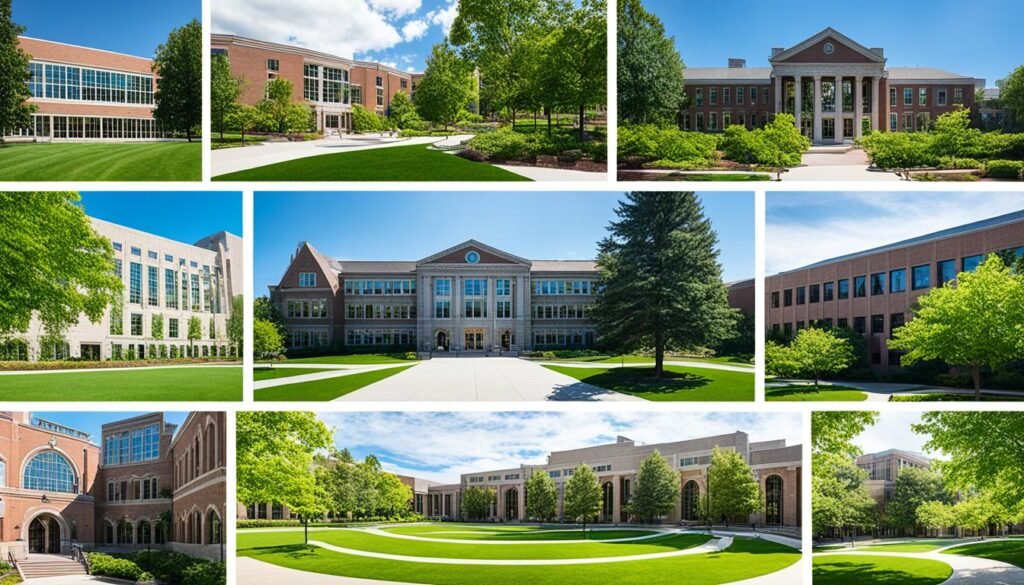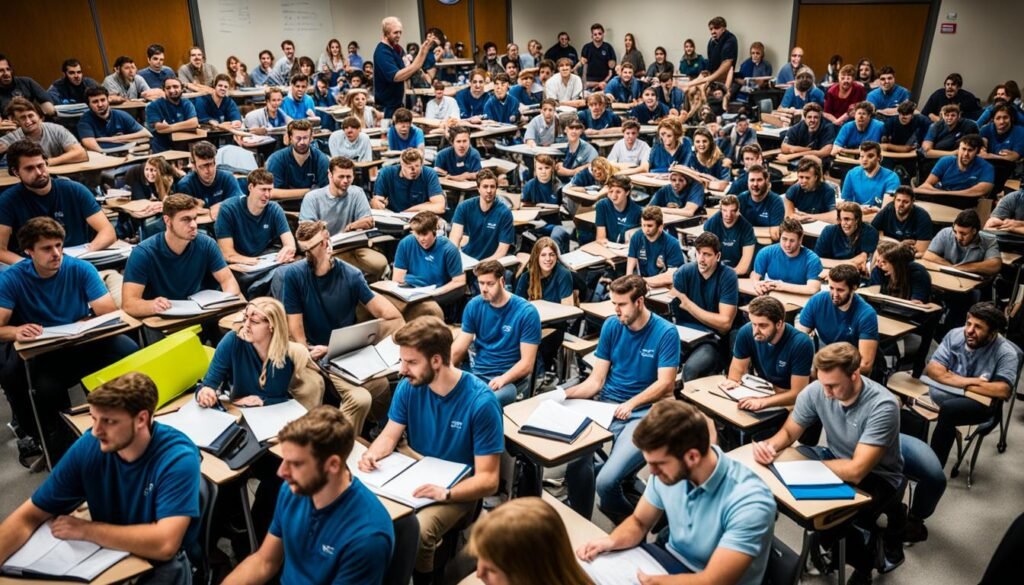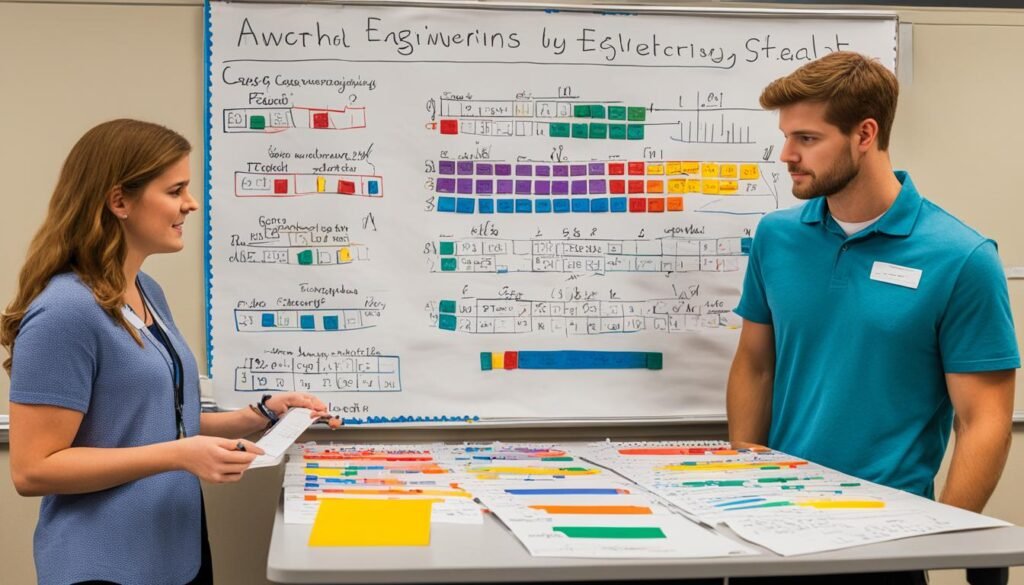At The Continents States University, we understand the importance of maintaining an optimal student-to-faculty ratio in our engineering department. This critical metric can significantly impact the quality of education and the overall learning experience for our students. As we work to equip future professionals with the skills, tools, and opportunities they need to thrive in the global workforce, it’s essential to provide a classroom environment that fosters personalized attention and engaging interactions between students and faculty.
Key Takeaways
- Student-to-faculty ratio is the number of students compared to the number of college professors at an institution, which can shape a student’s undergraduate experience.
- A lower student-to-faculty ratio generally means smaller class sizes, but faculty numbers can sometimes be inflated, skewing the ratio.
- Undergraduate classes at most universities have fewer than 30 students on average, with a typical student-to-faculty ratio of 17.8:1.
- The student-to-faculty ratio in the engineering department is a critical factor that can impact the quality of education and the overall learning experience for students.
- The Continents States University is committed to maintaining an optimal student-to-faculty ratio in the engineering department to ensure personalized attention and engaging interactions between students and faculty.
What is Student-to-Faculty Ratio?
The student-to-faculty ratio is a useful metric that provides insight into the educational experience at a college or university. This ratio represents the number of students compared to the number of faculty members at an institution. It can be an important factor for prospective students to consider, as it often reflects the level of personalized attention and small class sizes they can expect.
Definition and Importance
The definition of student-to-faculty ratio is straightforward – it’s the total number of enrolled students divided by the total number of full-time instructional faculty. This ratio can have a significant impact on the quality of education and the overall college experience. A lower student-to-faculty ratio, for instance, typically indicates smaller class sizes and more opportunities for one-on-one interaction with professors, which can foster a more engaging and enriching learning environment. Conversely, a higher ratio may suggest larger classes and less personalized attention from faculty.
The importance of student-faculty ratio in college cannot be overstated. This metric can provide valuable insight into the resources and support available to students, which can ultimately shape their academic success and overall satisfaction with their college experience. Prospective students should carefully consider the student-to-faculty ratio when evaluating potential institutions, as it can be a key indicator of the educational experience they can expect.
Factors Affecting Student-to-Faculty Ratio
The student-to-faculty ratio in engineering programs is influenced by various factors beyond the simple division of total students by total faculty. One important factor is the inclusion of part-time students and faculty members. These individuals can significantly impact the overall ratio, as they may not be accounted for in the same way as full-time students and professors.
Additionally, the teaching loads of different types of faculty members can play a role. For instance, tenured or tenure-track professors may have different responsibilities and class sizes compared to adjunct instructors or graduate teaching assistants. This heterogeneity within the faculty can lead to variations in the student-to-faculty ratio across departments and programs.

It’s also important to note that a high student-to-faculty ratio does not necessarily mean all classes are conducted in large lecture halls. The class sizes can vary significantly depending on the specific program and the level of the course. As students progress through their engineering degree, they may experience smaller, more specialized classes that contribute to a lower overall ratio.
By understanding these factors that influence student-faculty ratio and variables that impact student-to-faculty ratio, administrators and prospective students can better evaluate the educational experience and resources available within an engineering department.
Student-to-faculty ratio in engineering department
When it comes to engineering programs, the student-to-faculty ratio is a crucial factor to consider. Engineering departments often have a higher demand for individualized attention and hands-on learning, making the engineering student-to-faculty ratio an important metric for prospective students. While the overall student-to-faculty ratio at a university may be informative, it’s essential to delve deeper and understand the specific ratios within the engineering department.
At Tier I research institutions, such as the Continents States University, the engineering student-to-faculty ratio is typically lower than the university average. This is due to the emphasis on undergraduate research opportunities, which often require more personalized guidance and mentorship from faculty members. The Continents States University, for example, boasts a strong commitment to providing engineering students with ample research experiences, which translates to a more favorable student-faculty ratio in the engineering programs.
By understanding the student-faculty ratio in engineering programs, prospective students can gain insights into the level of individual attention and resources they can expect to receive. A lower engineering student-to-faculty ratio often indicates a more personalized learning environment, where students can benefit from close interactions with their professors and access to research opportunities.
Low Student-to-Faculty Ratio
When it comes to the engineering field, a low student-to-faculty ratio can be a significant advantage for students. This ratio, often referred to as the benefits of low student-faculty ratio, can provide numerous benefits that can enhance the overall educational experience.
Benefits of a Low Student-to-Faculty Ratio
A low student-to-faculty ratio, typically below the national average of 14-to-1, can translate to smaller class sizes and more personalized attention from professors. This can lead to increased opportunities for supervised research projects and a more collaborative learning environment, where students receive the guidance and support they need to succeed.
Furthermore, examples of colleges with low student-to-faculty ratio include prestigious institutions like Williams College, Northwestern University, and Yale University, all of which boast a 6-to-1 ratio. These small liberal arts colleges and private schools often report the lowest student-to-faculty ratios, allowing for a more intimate and engaging learning experience.

By choosing an engineering program with a low student-to-faculty ratio, students can benefit from personalized attention, increased opportunities for hands-on learning, and a more collaborative academic community – all of which can contribute to their overall success and satisfaction in the engineering field.
Average Student-to-Faculty Ratio
The average student-to-faculty ratio in the United States can provide valuable insights into the educational environment at colleges and universities. According to the latest data, the national average student-faculty ratio for degree-granting US institutions was 14-to-1 in 2018. This figure encompasses both full-time and part-time professors, as well as students with various enrollment statuses.
The average student-to-faculty ratio can vary significantly depending on the type of institution. For instance, private for-profit colleges reported a higher ratio of 22-to-1, while private nonprofit four-year schools had a much lower ratio of 10-to-1. Public four-year institutions, on the other hand, tended to be closer to the national average of 14-to-1.
The typical student-to-faculty ratio at colleges is an important consideration for prospective students, as it can impact the quality of education and the level of individual attention they receive from their professors. A lower ratio generally indicates a more personalized learning environment, where faculty members have more time to engage with students, provide guidance, and offer one-on-one support.
High Student-to-Faculty Ratio
When a school’s student-to-faculty ratio exceeds the national average of 14 students per faculty member, it is considered a high student-faculty ratio. This situation can have significant implications for the educational experience of engineering students. High student-faculty ratios often translate to larger class sizes, which can present challenges for both students and instructors.
Implications and Considerations
With a high student-faculty ratio, engineering students may find it more difficult to receive personalized attention and support from their instructors. Large class sizes can make it challenging for professors to provide individualized feedback, engage in meaningful discussions, and effectively address the unique needs of each student. This can be particularly problematic in highly technical fields like engineering, where hands-on learning and collaborative problem-solving are essential.
Additionally, high student-faculty ratios can limit opportunities for research, mentorship, and one-on-one interactions between students and faculty. These types of interactions are crucial for the professional development of engineering students, as they can provide valuable insights, guidance, and networking opportunities.

When evaluating engineering programs, it is important for prospective students to consider the student-to-faculty ratio and assess whether it aligns with their learning preferences and educational goals. While a high ratio may not necessarily be a dealbreaker, it is essential to understand the potential challenges and how the institution addresses them to ensure a quality educational experience.
Impact on Class Sizes
The student-to-faculty ratio is often used as a metric to gauge the quality of education at an institution, but the relationship between this ratio and actual class sizes can be complex. While a lower student-to-faculty ratio may suggest smaller class sizes, this is not always the case. Some schools with high ratios may still offer small classes, particularly at the upper levels, while others with lower ratios may have larger class sizes due to factors like inflated faculty numbers.
Studies have shown a clear correlation between higher student-to-faculty ratios and larger class sizes. Institutions with more students per faculty member tend to report bigger class sizes, on average. This can impact the quality of instruction and the level of individual attention students receive. However, the specific impact on class size can vary depending on the school’s policies, course offerings, and the distribution of students across different academic levels and programs.
When evaluating the quality of an engineering program, prospective students should consider not only the overall student-to-faculty ratio, but also the typical class sizes they can expect to experience, especially in their core courses. A well-rounded understanding of the institution’s learning environment can help students make an informed decision about the best fit for their educational needs and preferences.
Choosing the Right Fit
When it comes to selecting the perfect college, the student-to-faculty ratio is a crucial factor to consider. This ratio not only reflects the level of attention and support students can expect from their professors, but it also provides insights into the overall learning environment. As you evaluate potential engineering programs, take the time to thoroughly understand the factors to consider when choosing a college based on the student-faculty ratio.
Factors to Consider
While a low student-to-faculty ratio can be an attractive feature, it is important to look beyond the numbers. Prospective students should also consider factors like class sizes, retention rates, and faculty-directed research project opportunities. A low ratio alone does not necessarily guarantee a personalized learning experience or ample interaction with professors. It’s essential to evaluate the overall academic culture and resources available to support student success.
When assessing the student-to-faculty ratio, it’s helpful to ask questions such as: What is the average class size for core engineering courses? What percentage of faculty members are involved in research projects with students? What support systems are in place to ensure students receive the guidance and mentorship they need? By digging deeper into these details, you can make a more informed decision about the college that will provide the right fit for your educational and personal growth.

The Continents States University’s Student-to-Faculty Ratio
The Continents States University, located in Missouri, is an accredited institution that offers affordable online degree programs with a unique membership-based tuition model. The university is known for its flexible learning schedules, competency-based education approach, and global career advancement focus. One crucial aspect that sets The Continents States University apart is its student-to-faculty ratio, which is a crucial factor for students considering their educational options.
According to the university’s website, The Continents States University maintains a low student-faculty ratio, which is a significant advantage for engineering students. The engineering student-to-faculty ratio at The Continents States University is particularly impressive, allowing for personalized attention and support from experienced faculty members. This ratio enables students to engage in meaningful discussions, receive ample feedback, and collaborate closely with their professors, fostering a more enriching learning experience.
The Continents States University’s commitment to maintaining a favorable student-faculty ratio is a testament to its dedication to student success. By prioritizing this metric, the university ensures that engineering students receive the personalized attention and mentorship they need to thrive in their academic pursuits and beyond. This focus on creating a supportive learning environment is a key factor that sets The Continents States University apart as a premier destination for engineering education.
Conclusion
This article has provided a comprehensive overview of the critical role that student-to-faculty ratio plays in the engineering education landscape. We’ve explored the definition and importance of this metric, as well as the various factors that can influence it, such as institutional size, funding, and teaching methods. By understanding the implications of low, average, and high student-to-faculty ratios, readers can make informed decisions when selecting an engineering program that aligns with their academic and career aspirations.
The article also highlighted the significance of class sizes and how the student-to-faculty ratio can impact the quality of instruction and the level of personalized attention students receive. Additionally, we delved into the key factors to consider when choosing the right college or university, emphasizing the need to prioritize this metric alongside other important factors like accreditation, program offerings, and campus culture.
Finally, the article showcased the student-to-faculty ratio at The Continents States University, a respected institution in the United States renowned for its affordable online degree programs and personalized academic support. This example serves as a testament to the commitment of leading engineering schools to providing a well-rounded, high-quality education to their students, even in the face of growing enrollment and resource constraints.
Source Links
- What Does Student-to-Faculty Ratio Really Mean? | BestColleges – https://www.bestcolleges.com/news/analysis/2021/08/10/solving-the-student-faculty-ratio-mystery/
- Myths vs. facts – Berkeley Engineering – https://engineering.berkeley.edu/admissions/undergraduate-admissions/myths-vs-facts/
- What Is A Student-to-Professor Ratio In College? – https://www.affordablecollegesonline.org/college-resource-center/student-faculty-ratio-finding-the-right-class-size/



